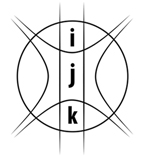2015 (8)
I finished the previous writing that in the geometric algebra it would be good to handle the scalar similarly as we use the real numbers in the number-planes of two-element numbers. One of the two-element numbers is the hyperbolic number-plane, and this number-plane is a model of the space-time, wherein the real axis is the time-axis and the imaginary axis is the space-dimension. A thought ensues from this model that in the geometric algebra there would be good a "time-like" view of the scalars (real numbers) namely it ought to regard the number-line of the real numbers as an axis perpendicular to the Euclidean vector space.
The Notion of Time and the Geometric Algebra „Only in the light of Grassmann’s outer product is it possible to understand that the careful Greek distinction between number and magnitude has real geometrical significance. It corresponds roughly to the distinction between scalar and vector. Actually the Greek magnitudes added like scalars but multiplied like vectors, so multiplication of Greek magnitudes involves the notions of direction and dimension, and Euclid was quite right in distinguishing it from multiplication of “Greek numbers” (our scalars).”/David Hestenes, New Foundations for Classical Mechanics/ Content 1. Memo1 about the special multiplications defined on the plane of two-element numbers 2. Differences between the definitions of multiplications defined on geometric algebra and defined on the planes of two-element numbers…
Sunday, 31 July 2016 10:34
Geometric Algebra for Physicists, by Chris Doran and Anthony Lasenby
Written by Mlakár Katalin
Preview In my previous article I mentioned the book of Hestenes on the same topic. I bought the book of the authors-duo Doran-Lasenby as well because the book of Hestenes mentions only a limited number of applications in the field of physics. I cannot form an opinion about the book yet, because only just started to read it together with Hestenes’s book. Here I have attached the table of contents to illustrate the themes of the book.
Sunday, 31 July 2016 10:28
New Foundations for Classical Mechanics by David Hestenes
Written by Mlakár Katalin
Preview I have already mentioned one of the books of David Hestenes; "Clifford Algebra to Geometric Calculus - A Unified Language for Mathematics and Physics", co-written by Garret Sobczyk. Both books begin by presenting the foundations of geometric algebra as used in abbreviated form; GA. But while one of them is mathematical explanation of the GA, the other focuses on some major applications in the field of physics. I cannot speak about the latter book, since only just started to read it. Instead of my opinion, here is a brief detail of reviews, which is readable at amazon.com: „While I found this a reasonably well-written text, I judge a book based upon how well it stands on its own - that is, can…
Yaroslav D. Sergeyev and the Infinity1 I reckon the theory grossone as a very attractive model because it tries to break Cantor’s concept of infinity. My problems related to Cantor's model of infinity could best articulate the my critique of his diagonal method.2 According to Cantor’s notion of infinity the part may be equal to the whole. The author of the grossone theory Sergeyev sees this as the inadequacy of Cantor’s model because this contradicts our intuitive approach as we observe it all around us that the part is less than the whole. Based on this intuitive insight the grossone model postulates that the part is less than the whole for the infinities as well. So Cantor's criticism of Sergeyev is…
The bivector and the equivalence of the parallelograms on the three number planes Abstract While we did not define an area on the number planes we defined the equivalence of the parallelograms based on the classic area context of the skew-scalar product. Accordingly parallelograms spanned by numbervector-pair on a number plane are equivalent if their skew-scalar products are equal. Contents1. History2. The equivalence of the parallelograms3. Summary
Path to the Infinities? "Mathematics is the queen of sciences and number theory is the queen of mathematics" (Carl Friedrich Gauss) The algebra started as a science of the counting and then it became general abstract area of the operations. The geometry evolved from the land-survey and it became the theoretical science of the spatial contexts. The calculation and measurement methods were more and more necessary because mathematics is becoming more and more abstract. So mathematics bifurcated into two areas and now we are making difference between pure and applied mathematics. No need to be explained why the number theory is the most important area in the theoretical and the applied mathematics. The science of numbers unbrokenly is the key area of…
Sunday, 31 July 2016 10:15
The two-element numbers as number lines described with homogeneous coordinates
Written by Mlakár Katalin
Contents: History Homogeneous coordinates and the number lines Parabolic (number) line Hyperbolic (number) line Complex or elliptic (number) line Summary



